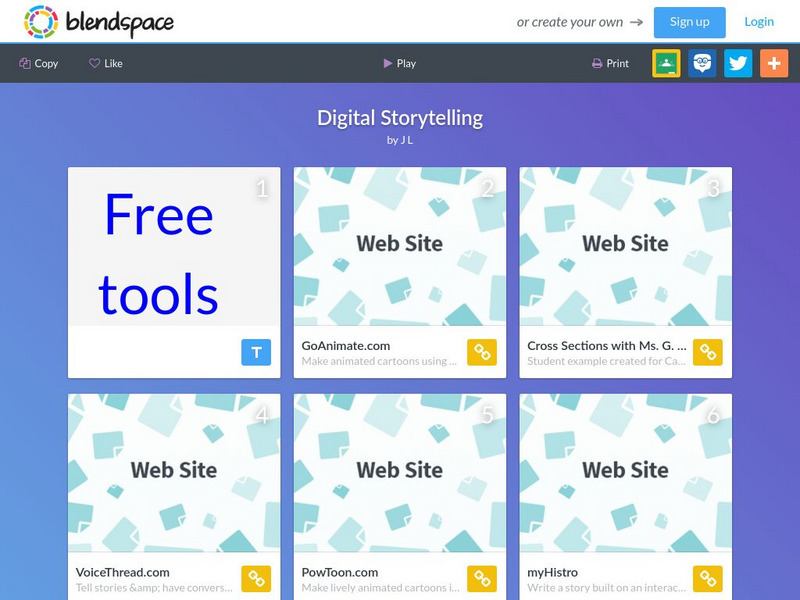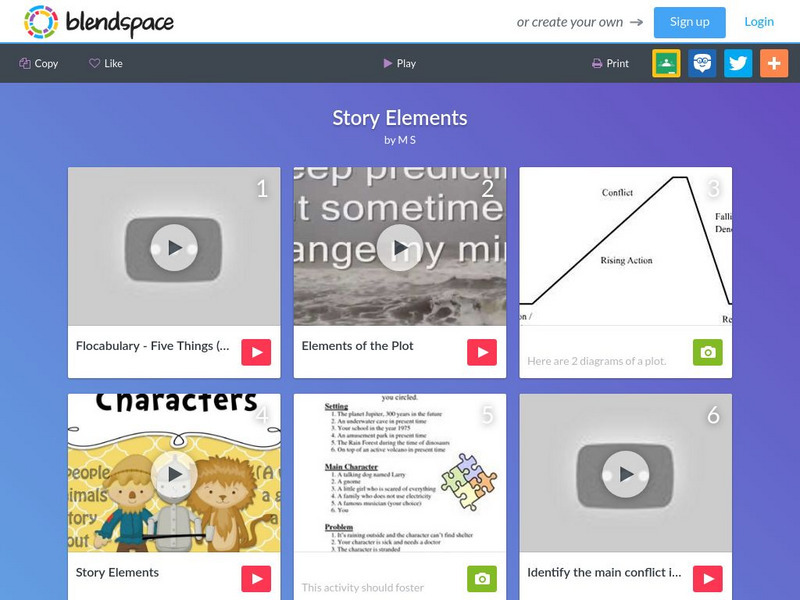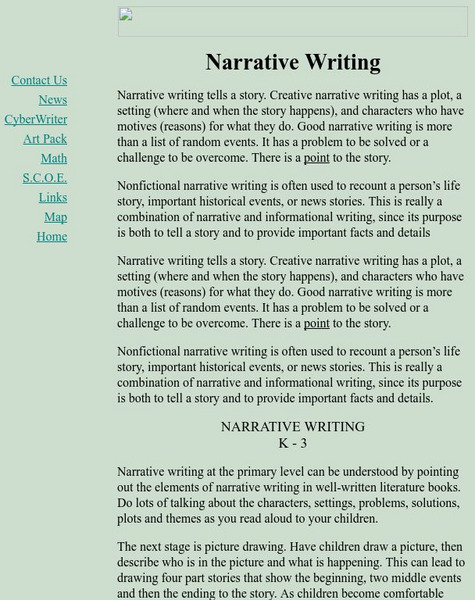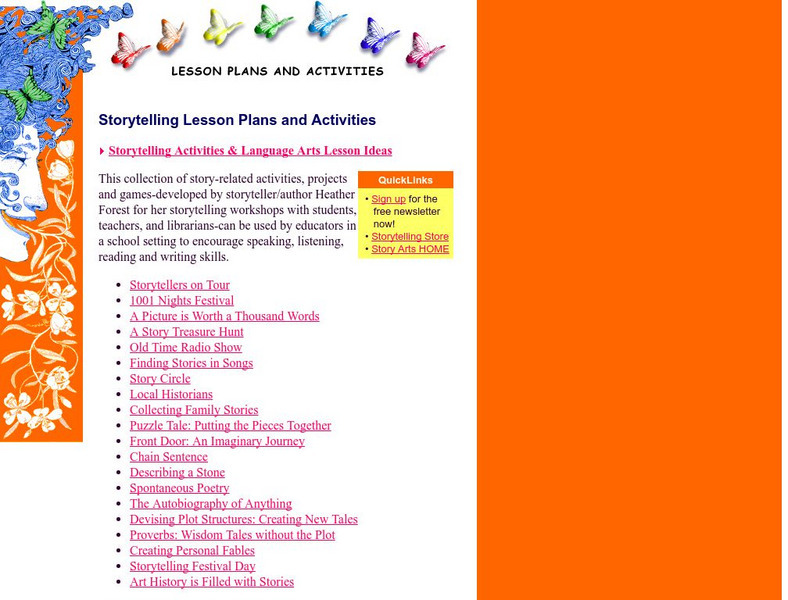Better Lesson
Better Lesson: Unit: Character Development in Historical Fiction: Bud, Not Buddy
Big Ideas: Authors write historical fiction to show the reader what it was like to live in a certain time period. Readers can use historical fiction to learn about new settings. People are influenced by and react to their setting so you...
TES Global
Blendspace: Digital Storytelling
Links to eight different online storytelling websites available for free student use followed by an assessment.
TES Global
Blendspace: Story Elements
A twelve-part learning module with links to videos, images, and websites to use while learning about story elements and the development of a plot.
ClassFlow
Class Flow: Story Fairytale
[Free Registration/Login Required] Students learn the elements of a story through fairytales. These include character, setting, plot, and secret ingredient. Includes an Activote session.
ClassFlow
Class Flow: Dialogue
[Free Registration/Login Required] This flipchart introduces the rules of writing dialogue and allows students the opportunity to interact with the Activboard and elements of dialogue. Includes practice worksheets.
ClassFlow
Class Flow: Digital Storytelling With Class Flow Technology
[Free Registration/Login Required] Digital storytelling is the combination of the ancient art of oral storytelling with today's technology, enabling students to write their own uniquely personal tales and then personalize them even more...
Can Teach
Can Teach: Tabloid Science Fiction
For this lesson plan students will write science fiction stories based on stories brought up in the tabloids. Lesson plan indicated for 5th grade and above.
BBC
Bbc Bitesize Revision: Dialogue and Description
As part of a revision and writing section of BBC Bitesize, this page provides several tips involved in writing dialogue and description for short story fiction.
Sophia Learning
Sophia: Characters and Plot
This lesson introduces the connection between characters and plot in fiction writing.
Other
Cyberwriter: Narrative Writing
Cyberwriter gives narrative writing activities leveled for K-3rd grades and 4th-8th grades. A brief explanation about narrative writing is also on this page. CCSS.ELA-Literacy.CCRA.W.3
Caro Clarke
Caro Clarke: Writing Advice: Beginner's Four Faults
This site is a personal site from Caro Clarke. The third installment in this series looks at the four major mistakes made by beginning authors. The main idea of this article is that the author needs to be able to combine dialogue with...
Other
Story Arts:storytelling Activities & Lesson Ideas
Use this site to get students interested in and enthusiastic about storytelling with these cool lesson ideas. Look through these short descriptions of lesson ideas to help develop a lesson to fit your classroom needs.
TES Global
Blendspace: What Makes Stories Scary?
A learning module that includes fourteen links to websites, videos, and activities on writing scary stories. Lessons focus on vocabulary, plot and character development, elements of gothic stories, tone and mood, suspense, and more.
Quizlet
Quizlet: Flash Cards: Vocabulary 1: Nonfiction
These interactive flashcards focuses on terms relating to nonfiction. These terms include the following: nonfiction, fiction, glossary, index, table of contents, headings, subheadings, caption, boldface, italicized, preface, sidebar, and...
Quizlet
Quizlet: Plot Terms: 7th Grade Level Match
Race against the clock to match each story element with its definition. Terms include: plot, introduction, conflict, rising action, climax, falling action, conclusion/resolution, sub-plot, parallel episode, flashback, and foreshadowing.
Quizlet
Quizlet: Plot Terms: 7th Grade Level Flashcards
Eleven flashcards on the elements of a story including: plot, introduction, conflict, rising action, climax, falling action, conclusion/resolution, sub-plot, parallel episode, flashback, and foreshadowing.
Quizlet
Quizlet: Story Elements Quiz: 6th Grade: Flashcards
This set of interactive flashcards focuses on story elements such as setting, characters, conflict, rising action, falling action, exposition, protagonist, antagonist, and resolution.
SMART Technologies
Smart: Characters and Characterization
This activity addresses the types of characters found in stories and the methods authors use to build characters.
PBS
Pbs Learning Media: Building Video Literacy: Storyboarding
In this activity developed by EDC's Center for Children and Technology, students explore the relationship between types of shots and storytelling.
Scholastic
Scholastic: Nonfiction Writing Lessons
This series of nonfiction writing lessons was developed by Stuart Miller. Four activities include: Describing the Real World, The Interview, Writing a Profile, and Writing a Review.
SMART Technologies
Smart: Leads in Narrative Writing
This lesson explains the purpose of a lead and introduces students to 6 different types of leads they can use in their writing.
Alabama Learning Exchange
Alex: Dialogue With Student Created Characters
This lesson is designed to help students understand the importance of character development when writing stories of their own. It also helps them understand the process authors use when writing novels and other stories. During this...
Annenberg Foundation
Annenberg Learner: Literature: Creating Character
This article provides good insight into the creation of a character.





















